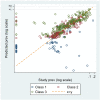Estimating hepatitis B virus prevalence among key population groups for European Union and European Economic Area countries and the United Kingdom: a modelling study
- PMID: 37430220
- PMCID: PMC10331985
- DOI: 10.1186/s12879-023-08433-3
Estimating hepatitis B virus prevalence among key population groups for European Union and European Economic Area countries and the United Kingdom: a modelling study
Abstract
Background: Hepatitis B virus (HBV) epidemiology in Europe differs by region and population risk group, and data are often incomplete. We estimated chronic HBV prevalence as measured by surface antigen (HBsAg) among general and key population groups for each country in the European Union, European Economic Area and the United Kingdom (EU/EEA/UK), including where data are currently unavailable.
Methods: We combined data from a 2018 systematic review (updated in 2021), data gathered directly by the European Centre for Disease Control (ECDC) from EU/EEA countries and the UK and further country-level data. We included data on adults from the general population, pregnant women, first time blood donors (FTBD), men who have sex with men (MSM), prisoners, people who inject drugs (PWID), and migrants from 2001 to 2021, with three exceptions made for pre-2001 estimates. Finite Mixture Models (FMM) and Beta regression were used to predict country and population group HBsAg prevalence. A separate multiplier method was used to estimate HBsAg prevalence among the migrant populations within each country, due to biases in the data available.
Results: There were 595 included studies from 31 countries (N = 41,955,969 people): 66 were among the general population (mean prevalence ([Formula: see text]) 1.3% [range: 0.0-7.6%]), 52 among pregnant women ([Formula: see text]1.1% [0.1-5.3%]), 315 among FTBD ([Formula: see text]0.3% [0.0-6.2%]), 20 among MSM ([Formula: see text]1.7% [0.0-11.2%]), 34 among PWID ([Formula: see text]3.9% [0.0-16.9%]), 24 among prisoners ([Formula: see text]2.9% [0.0-10.7%]), and 84 among migrants ([Formula: see text]7.0% [0.2-37.3%]). The FMM grouped countries into 3 classes. We estimated HBsAg prevalence among the general population to be < 1% in 24/31 countries, although it was higher in 7 Eastern/Southern European countries. HBsAg prevalence among each population group was higher in most Eastern/Southern European than Western/Northern European countries, whilst prevalence among PWID and prisoners was estimated at > 1% for most countries. Portugal had the highest estimated prevalence of HBsAg among migrants (5.0%), with the other highest prevalences mostly seen in Southern Europe.
Conclusions: We estimated HBV prevalence for each population group within each EU/EAA country and the UK, with general population HBV prevalence to be < 1% in most countries. Further evidence is required on the HBsAg prevalence of high-risk populations for future evidence synthesis.
Keywords: Europe; General population; Hepatitis B; Migrant; Prevalence; Risk groups.
© 2023. The Author(s).
Conflict of interest statement
PV and JGW reports research grants from Gilead unrelated to this work. All other authors do not have competing interests.
Figures



References
-
- World Health Organization . Hepatitis B Fact sheet. Geneva, Switzerland: World Health Organization; 2022.
-
- World Health Organization. Combating hepatitis B and C to reach elimination by 2030. 2016.
-
- European Centre for Disease Prevention and Control . Monitoring of responses to the hepatitis B and C epidemics in EU/EEA countries – 2020 data. Stockholm, Sweden: European Centre for Disease Prevention and Control; 2022.
-
- Mason LMK, Duffell E, Veldhuijzen IK, Petriti U, Bunge EM, Tavoschi L. Hepatitis B and C prevalence and incidence in key population groups with multiple risk factors in the EU/EEA: a systematic review. Eurosurveillance. 2019;24(30):5–20. doi: 10.2807/1560-7917.ES.2019.24.30.1800614. - DOI - PMC - PubMed
MeSH terms
Substances
Grants and funding
LinkOut - more resources
Full Text Sources

